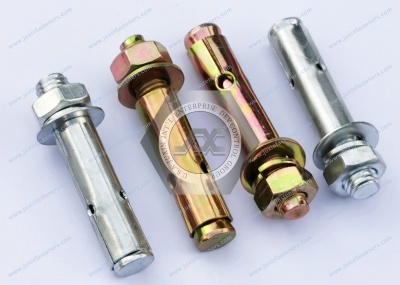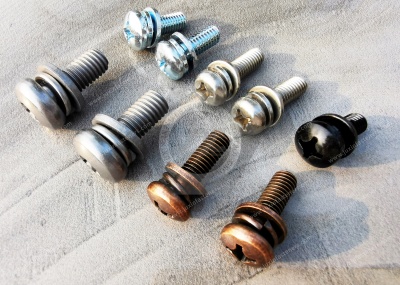Call Us
+86 136 6007 9809
Call Us
+86 136 6007 9809
Aug. 13, 2024
The primary forms of automotive fastener failure due to poor quality
The importance of automotive fasteners is generally divided into three kinds.
First, security fasteners, referred to as "security fasteners" or "security parts," refers to the failure of the fastener, may lead to fatal vehicle failure fasteners;
Critical fasteners, or "critical parts" for short, are fasteners whose failure could result in a severe vehicle failure;
Third, general fasteners, referred to as "general parts," refer to the fastener failure, which may only lead to general or minor vehicle fasteners.
Functional failure of fasteners refers to the complete loss of specified function in service. Vehicle failure in long-term operation or light failure can cause severe and even fatal failure, many from the automotive fasteners due to poor quality and failure caused by.
Common automotive fastener failure of the primary forms of fracture or rupture, slack, shedding, etc.
Nickel Alloy Socket Head Screws: More corrosion resistant than stainless steel screws, nickel alloy screws have excellent resistance to salt water and some acids. Material is comparable to Monel. They may be mildly magnetic. Length is measured from under the head.
Coarse threads are the industry standard; choose these screws if you don't know the threads per inch. Fine threads are closely spaced to prevent loosening from vibration. They are not compatible with coarse threads.
Alloy Steel Low-Profile Socket Head Screws: Made of alloy steel, these low-profile screws are nearly twice as strong as their stainless steel counterparts. With half the height of a standard socket head, these low-profile screws fit in tight spaces but are weaker than standard socket heads. Length is measured from under the head.
Black-oxide steel screws are mildly corrosion-resistant in dry environments. Zinc-plated steel screws have a zinc outer layer that protects the steel under it from rust, extending the life of the screw.
Class 8.8 steel screws are medium-strength, so they're robust enough for use with most machinery and equipment. Class 10.9 steel screws are high-strength—they are at least 25% stronger than Class 8.8. Use them for high-stress applications such as valves, pumps, and automotive suspensions.
Coarse threads are the industry standard; choose these screws if you don't know the pitch or threads per inch. Fine threads are closely spaced to prevent loosening from vibration. They are not compatible with coarse threads.
Screws that meet ASTM A574 comply with specifications and testing requirements for material quality.
DIN screws meet international standards for materials and dimensions.


Tighten DIN 6912 screws with DIN 6911 L-keys—these screws have a recess that matches the extended tip of those L-keys. DIN 6911 L-keys grip these screws snugly so you can install them in difficult-to-reach areas with just one hand. You can also install DIN 6912 screws with standard L-keys, but they won't grip the screws as securely.
316 Stainless Steel Ultra-Low-Profile Socket Head Screws: More corrosion resistant than 18-8 stainless steel screws, these 316 stainless steel screws have excellent resistance to chemicals and salt water. They may be mildly magnetic. To fit in the tightest spaces, they have a head about one-third the height of a standard socket head, but their low profile weakens their head. It is not recommended for critical fastening applications. These screws have a shoulder that provides some support and stability to the head. Length is measured from under the shoulder.
Coarse threads are the industry standard; choose these screws if you don't know the threads per inch. Fine threads are closely spaced to prevent loosening from vibration. They are not compatible with coarse threads.
High-Profile Socket Head Screws: With a head one and a half times taller than a standard socket head, these screws are easier to install in deep counterbored holes and other hard-to-reach places. They're made from 18-8 stainless steel with good chemical resistance and may be mildly magnetic. Length is measured from under the head.
Coarse threads are the industry standard; choose these screws if you don't know the threads per inch. Fine threads are closely spaced to prevent loosening from vibration. They are not compatible with coarse threads.
Flanged Socket Head Screws: Eliminate the need for a separate washer—these screws distribute pressure where the screw meets the surface without taking up as much space as a washer. Made of alloy steel, they are stronger than stainless steel screws. Their black-oxide finish provides mild corrosion resistance in dry environments. Head height includes the flange. Length is measured from under the flange.
Coarse threads are the industry standard; choose these screws if you don't know the pitch or the threads per inch. Fine threads are closely spaced to prevent loosening from vibration. They are not compatible with coarse threads.
Exact-Grip-Length Flanged Socket Head Screws: For use where sideways forces are a concern, these screws have a precisely measured unthreaded portion (grip) for a firm hold. The flange distributes pressure where the screw meets the surface, eliminating the need for a separate washer. Made from 18-8 stainless steel, these screws have good chemical resistance and may be mildly magnetic. Head height includes the flange. Length is measured from under the flange.
Coarse threads are the industry standard; choose these screws if you ddon'totnow the threads per inch. Fine threads are closely spaced to prevent loosening from vibration. They are not compatible with coarse threads.
1.Delayed fracture
Delayed fracture refers to the role of the material in the static stress after a certain period of time after the sudden brittle destruction of a phenomenon. It mainly occurs in bolts, studs, and other external threaded fasteners. This is an external force that does not exceed the design of the permissible static load or dynamic load, with the use of time increasing in months or years after the occurrence of a sudden fracture.
There are many reasons for delayed fracture, such as the environment of vehicle use, the materials used in the parts and the manufacturing process, the shape and strength of the parts, and the sensitivity of delayed damage. The American above General Motors adjustable arm bolt problem is a typical example of delayed damage. The delayed fracture phenomenon is the material, environment, stress interaction, and the occurrence of environmental embrittlement, which is a form of hydrogen leading to material deterioration. The delayed fracture phenomenon is a significant factor hindering the high strength of steel for fastener-type bolts. It can be broadly divided into the following two categories.
One is delayed fracture, caused mainly by hydrogen intruding from the external environment. For example, automobiles, bridges, and other bolts are exposed to humid air, rain, and different environments for a long time, resulting in hydrogen damage.
The second is the delayed fracture caused by hydrogen (internal hydrogen) that invades the steel during the manufacturing process, such as pickling and electroplating treatment. Electroplated bolts, etc., in the absence of dehydrogenation or dehydrogenation, s are incomplete when loaded after a few hours or days of a relatively short period and delayed fracture.
For the former, corrosion is generally due to long-term exposure, and corrosion pits are formed in the corrosion reaction generated by hydrogen intrusion; the latter is due to the manufacturing process, such as pickling and plating treatment of hydrogen intrusion into the steel in the role of stress to the concentration of stress caused by the concentration.
In practical steel in the natural environment, delayed fracture occurs mainly in quenched and tempered martensitic steel. The material's composition, organization, and mechanical properties are related to delayed fracture susceptibility. Steel containing P, S, Si, and Mn promotes delayed fracture. It is generally believed that the higher the strength of the steel, the greater the delayed fracture sensitivity; in the tensile strength greater than 900MPa, hardness ≥ 31HRC strength level, the sensitivity of delayed fracture gradually increased. Now, although it has been possible to prevent the design, manufacturing, such as the use of delayed damage to the low sensitivity of the material, avoiding the use of sensitive strength zone, reducing or preventing the use of hydrogen may penetrate the parts of the process (e.g., plating, excessive pickling, etc.) or through the post-treatment will be hydrogen driven off and so on. However, given the complexity and variety of causes, eliminating them doesn't seem easy.
2.Fatigue fracture
Bolt coupling is a widely used form of coupling in machinery manufacturing and mechanical equipment installation. People for bolt fatigue damage are not easy to find, and it has been difficult to prevent over the years due to bolt fatigue fractures caused by significant accidents in the country from time to time. According to statistics, fastener fracture failure mode and fatigue failure account for about 60% to 90% of the total.
The fatigue damage mechanism is relatively simple; it is caused by the dynamic load, starting from the stress concentration point. The main stress concentration points are in the threaded part and the rounded corner between the head of the bolt and the rod. Due to the characteristic notch-sensitive structure of threaded parts, fatigue fracture is the most visible form of fracture of threaded fasteners under dynamic loading conditions; the reason is that the fatigue life of the parts tends to have some limitations, and the complexity of factors affecting the degree of its discrete if its fatigue life is lower than the whole life, it is evident that it will be broken sometime in the use of the entire vehicle.
In the manufacturing and use of metal parts, due to forging defects, welding cracks, surface scratches, non-metallic inclusions, corrosion pits, and other reasons, often the surface of the part has produced various types of cracks when it is subjected to alternating loads, even if the load is far lower than the fatigue limit of the material, the cracks may be extended, resulting in catastrophic damage to the machine.
The use of tempering, carburizing, and surface treatment by changing the organization of the material can be achieved to improve fatigue performance (including stress corrosion performance). Today, the surface shot peening process, has been adopted in the bolt, screw rod, the use of more, adaptability is also widely available, the cost is also inexpensive.
3, poor quality fasteners
Counterfeit and shoddy fasteners, both at home and abroad, have been, and still are, and will continue to be a severe problem; billions of sub-standard, mislabeled, and shoddy fasteners threaten the reliability of industrial and consumer products as well as national security. Substandard fasteners waste money and, in some cases, can lead to significant accidents. Inferior fasteners will inevitably lead to those in line with the design requirements. There would have been no problem in the parts of the trigger failure, or even fatal failure, which is a hidden accidental failure factor.
4, not standardized fastening
The reliability of thread fastening depends on the design, fasteners, and fastening aspects. Maintenance will often replace or disassemble fasteners. All over the country, the level of difference between the maintenance points means there is bound to be unregulated fastening operations. Poor-quality fastening with poor-quality fasteners is another factor in the occurrence of unexpected failures.
For high-quality Exact-Grip-Length Flanged Socket Head Screws for High Vacuum and professional technical support, please get in touch with us at adelajonly@gmail.com or visit our website at https://www.juxinfasteners.com.
Contact Us
Tel.:
+86 020 8621 0320
+86 020 3121 6067
Technical Support:
Navigation
SEND INQUIREY